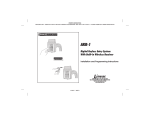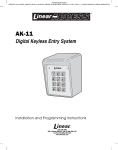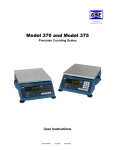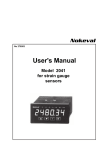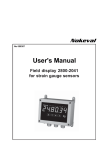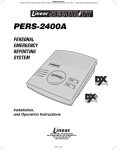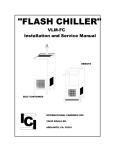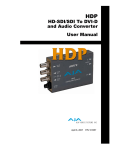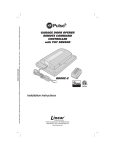Download Linear AK-3 User's Manual
Transcript
PRINTER’S INSTRUCTIONS: INSTR,INSTL,AK-3 - LINEAR P/N: 221025 B - INK: BLACK - MATERIAL: 20 LB. MEAD BOND - SIZE: 8.500” X 11.000” - SCALE: 1-1 - FOLDING: ALBUM-FOLD - BINDING: SADDLE-STITCH AK-3 Digital Keyless Entry System 1 2 3 4 5 6 7 8 9 0 Installation and Programming Instructions (760) 438-7000 USA & Canada (800) 421-1587 & (800) 392-0123 Toll Free FAX (800) 468-1340 www.linearcorp.com 221025 B IMAGE 1 CONTENTS COMPONENT LOCATIONS . . . . . . . . . . . . . . . . . . . . . . . . . . . . . . . . . . . . . . . WIRING DIAGRAM . . . . . . . . . . . . . . . . . . . . . . . . . . . . . . . . . . . . . . . . . . . INSTALLATION . . . . . . . . . . . . . . . . . . . . . . . . . . . . . . . . . . . . . . . . . . . . . . . Opening the Keypad . . . . . . . . . . . . . . . . . . . . . . . . . . . . . . . . . . . . . . . Install the Electrical Box and Mounting Plate . . . . . . . . . . . . . . . . . . . . . . Final Keypad Installation . . . . . . . . . . . . . . . . . . . . . . . . . . . . . . . . . . . . Keypad Wiring . . . . . . . . . . . . . . . . . . . . . . . . . . . . . . . . . . . . . . . . . . . Solid State Outputs . . . . . . . . . . . . . . . . . . . . . . . . . . . . . . . . . . . . . . . . FACTORY DEFAULTS . . . . . . . . . . . . . . . . . . . . . . . . . . . . . . . . . . . . . . . . . . . BASIC PROGRAMMING . . . . . . . . . . . . . . . . . . . . . . . . . . . . . . . . . . . . . . . . PROGRAMMING OPTIONS . . . . . . . . . . . . . . . . . . . . . . . . . . . . . . . . . . . . . . RESETTING KEYPAD . . . . . . . . . . . . . . . . . . . . . . . . . . . . . . . . . . . . . . . . . . . Master Reset . . . . . . . . . . . . . . . . . . . . . . . . . . . . . . . . . . . . . . . . . . . . Resetting the Master Code. . . . . . . . . . . . . . . . . . . . . . . . . . . . . . . . . . . AK-3 OPERATION . . . . . . . . . . . . . . . . . . . . . . . . . . . . . . . . . . . . . . . . . . . . SPECIFICATIONS. . . . . . . . . . . . . . . . . . . . . . . . . . . . . . . . . . . . . . . . . . . . . . LINEAR LIMITED WARRANTY . . . . . . . . . . . . . . . . . . . . . . . . . . . . . . . . . . . . IMPORTANT !!! . . . . . . . . . . . . . . . . . . . . . . . . . . . . . . . . . . . . . . . . . . . . . . FCC NOTICE . . . . . . . . . . . . . . . . . . . . . . . . . . . . . . . . . . . . . . . . . . . . . . . . . FEATURES 1 1 2 2 2 2 3 3 4 4 4 6 6 6 6 6 6 6 6 INTRODUCTION Linear’s AK-3 is a digital keyless entry system designed for access control applications. The keypad is housed in a rugged, plastic enclosure and is designed to be mounted in a standard single-gang electrical box. The die-cast keys have bright, easy-to-read yellow graphics. Up to 480 entry codes, from 1 to 6 digits in length, can be programmed. They can activate either, or both, of the relay outputs. The “anti-passback” feature prevents using the same code again before the programmed time elapses. All system indicators are long-lasting, solid-state LEDs. Two indicators show the status of the entry system. The left indicator lights red to indicate power, then turns green when access is granted. The right indicator lights yellow when the keypad is in “lockout” condition (from too many incorrect code entries). An internal sounder beeps when each key is pressed. An internal jumper sets the sounder volume high or low. The SENSE input can be used two ways. If programmed for “door sense” the input is wired to a normally closed switch on the door to detect when the door is open or closed. Forced entry or door ajar situations can then be detected. Using door sense, the “Auto-relock” feature will prevent “tailgating” by turning off the Main Relay output immediately when the door is closed after access has been granted. If the SENSE input is programmed for “inhibit”, the input can be wired to a “service” switch or automatic timer that will disable the Main Relay when required. The REQUEST-TO-EXIT input can be wired to a pushbutton to provide codeless activation of Main Relay, Auxiliary Relay, Output #3, or Output #4 (programmable). The ALARM SHUNT output activates when access is granted. This output can be wired to shunt alarm contacts on the access door/gate to prevent triggering of an alarm when authorized access occurs. The AK-3 is powered from a 12-24 Volt AC or DC source. Power can be obtained from the access device or a separate power supply. The EEPROM memory retains all entry codes and programming, even without power. An internal jumper is provided to reset the master code. The Main Relay has a 5 Amp capacity. The Auxiliary Relay has a 1 Amp capacity. Two solid state outputs, capable of switching 100 mA to common, are programmable to signal forced entry, door ajar, lockout, alarm circuit shunting, request-to-exit, and keypad active conditions. ✓ KEYPAD PROGRAMMABLE No programmer required ✓ 480 ENTRY CODE CAPACITY Ideal for small & medium traffic installations ✓ 1-6 DIGIT ENTRY CODE LENGTH Flexible code length for different applications ✓ 4 INDEPENDENT OUTPUTS (TIMED/TOGGLED) Each output’s action is programmable ✓ 4 INDEPENDENT TIMERS Each output’s activation time is programmable ✓ TWO FORM “C” (N.O. & N.C) RELAY CONTACTS Main Relay 5-Amp @ 28 VDC capacity, Auxiliary Relay 1-Amp @ 28 VDC capacity ✓ EACH ENTRY CODE CAN ACTIVATE EITHER OR BOTH RELAYS Specific entry codes can grant access to different doors ✓ TWO SOLID STATE OUTPUTS Auxiliary outputs can indicate access status on external devices ✓ TWO STATUS INDICATORS (2-COLOR RED/GREEN & YELLOW) Displays access, lockout, and programming information ✓ PIEZO SOUNDER (TWO SELECTABLE VOLUME LEVELS) Programmable for beeps during key presses and output activations ✓ TIMED ANTI-PASSBACK Disables entry code for a programmed time after use ✓ AUTO-RELOCK Releases the main relay as soon as the door shuts ✓ KEYPAD LOCKOUT Locks the keypad after too many incorrect entries ✓ TACTILE KEY FEEL Assures complete key presses ✓ DOOR SENSE INPUT For sensing door position to control auto-relock and door-ajar features ✓ INHIBIT INPUT For temporarily disabling access with a timer or switch ✓ REQUEST-TO-EXIT INPUT For codeless activation with a pushbutton ✓ KEYPAD CAN BE POWERED FROM 12-24 VOLTS AC OR DC Power can be supplied from a transformer, battery, or power supply 221025 B IMAGE 2 COMPONENT LOCATIONS RED/GREEN POWER/ACCESS INDICATOR YELLOW "LOCKOUT" INDICATOR MASTER CODE RESET JUMBER (P5) TERMINAL BLOCK #1 (TB1) 1 2 3 4 5 6 7 8 9 0 KEYPAD BEEPER LEVEL JUMPER (P4) MOUNTING PLATE Figure 1. Component Locations WIRING DIAGRAM TYPICAL DOOR INSTALLATION WIRING AK-3 TERMINALS TERMINAL BLOCK 1 1 - AC OR DC POWER SUPPLY 2 - AC OR DC 12-24 VOLT AC OR DC POWER 3 - N.O. MAIN RELAY 4 - COM 5 AMPS @ 28 VDC MAX. 5 - N.C. ELECTRIC DOOR STRIKE 6 - N.O. AUXILIARY 7 - COM RELAY 1 AMP @ 28 VDC MAX. 8 - N.C. WIRES SENSE - 8 GROUND - 7 REQUEST-TO-EXIT - 6 GROUND - 5 GROUND - 4 OUTPUT #3 - 3 OUTPUT #4 - 2 GROUND - 1 GRAY N.C. DOOR SWITCH BLACK VIOLET BLACK REQUEST TO EXIT BUTTON BLACK BLUE GREEN BLACK AUXILIARY OUTPUTS 100 mA MAX. TO COMMON GROUND STAKE TO ALARM SYSTEM REQUIRED WIRING OPTIONAL WIRING ALARM CONTACT CAUTION NOTES: 1. ALARM SHUNT SET FOR AUXILIARY RELAY 2. GRAY WIRE SET FOR DOOR SENSE IF THE UNIT IS AC POWERED, MAKE SURE THE SECONDARY OF THE SYSTEM TRANSFORMER IS ISOLATED FROM EARTH GROUND OTHER WIRING Figure 2. Wiring Diagram 1 221025 B IMAGE 3 INSTALLATION Before installing the keypad, the unit must be partially disassembled to access the mounting plate. Opening the Keypad The keypad assembly is secured with two screws that are hidden behind the keypad’s nameplate. Refer to Figure 3 for disassembly details. ❑ Use a small flat blade screwdriver to pry off the keypad’s nameplate. ❑ Use a philips head screwdriver to remove the two screws. ❑ Separate the mounting plate from the keypad assembly. Final Keypad Installation After wiring the keypad (see next page), complete the installation by securing the keypad to the mounting plate. ❑ If a lower beeper sound level is required, before installing the keypad, remove Jumper at P4 (place the jumper block on one pin to save the jumper). ❑ Hook the keypad assembly onto the mounting plate tab (see Figure 5). ❑ Secure with two philips screws. ❑ Snap nameplate into position over screws. 1 PRY UP ON THE 1 HOOK THE KEYPAD ASSEMBLY NAMEPLATE HERE ONTO THE MOUNTING PLATE 2 INSTALL THE TWO SCREWS 2 REMOVE THE TWO SCREWS MOUNTING PLATE 3 SNAP THE NAMEPLATE INTO PLACE 3 SEPARATE THE MOUNTING PLATE FROM THE KEYPAD Figure 3. Opening the Keypad Figure 5. Connecting the Keypad to the Mounting Plate Install the Electrical Box and Mounting Plate The keypad is designed to fit into a standard single-gang electrical box. Select a location near the controlled door and choose a convenient height for the keypad. Be sure there is good wiring accessibility for the unit’s power and the output to the door strike or access device. ❑ Install the electrical box in the wall. ❑ Screw the mounting plate onto the electrical box (see Figure 4). INSTALL A SINGLE-GANG ELECTRICAL BOX AT THE PROPER LOCATION FOR THE KEYPAD MAKE SURE THE TAB IS UP ATTACH THE MOUNTING PLATE TO THE ELECTRICAL BOX MOUNTING PLATE Figure 4. Installing the Mounting Plate 2 221025 B IMAGE 4 Keypad Wiring See Figure 6 for an example of a basic door installation. The keypad is mounted adjacent to the door. An electric door strike is mounted in the door jamb to release the door lock. A magnetic switch is mounted on the top of the door jamb for detecting when the door is open. Use the following steps to wire the keypad. Refer to the wiring diagram shown in Figure 7 to assist in the wiring. ☞ NOTE: Up to 500 feet of 18 AWG wire can be run for power, use larger wire for longer runs. Use 22 AWG or larger (depending on the load) for other connections. 2 WIRES FOR DOOR SENSE SWITCH DOOR SENSE SWITCH 2 WIRES FOR DOOR STRIKE AK-3 KEYPAD 1 2 3 4 5 6 9 7 OUTPUT ❑ Install a low voltage electric door strike for unlocking the door. ❑ Route two wires between the door strike and the keypad box. Connect one of the door strike wires to the keypad’s MAIN RELAY N.O. terminal (TB1 #3). Connect the other door strike wire to the keypad’s AC/DC + terminal (TB1 #1). Connect a wire between the keypad’s AC/DC - terminal (TB1 #2) and the MAIN RELAY COM terminal (TB1 #4). 2 WIRES FROM POWER SUPPLY ELECTRIC DOOR STRIKE 1 WIRE TO EARTH GROUND Figure 6. Basic Door Installation POWER ❑ Choose a location for the power supply or transformer. ❑ Route two wires between the power supply and the keypad box. Connect the power supply’s output terminals to the keypad’s AC/DC input terminals (TB1 #1 & #2). Observe wiring polarity if using DC. ✦ CAUTION: If the unit is AC powered, make sure the secondary of the system transformer is isolated from earth ground. TERMINAL BLOCK 1 12-24 VOLT AC OR DC POWER SUPPLY 1 - AC OR DC 2 - AC OR DC 3 - N.O. 4 - COM ELECTRIC DOOR STRIKE REQUEST-TO-EXIT INPUT (wiring shown on Page 1, Figure 2) ❑ If a request-to-exit pushbutton is going to be used, route two wires from the keypad box to a normally open pushbutton mounted on the secure side of the door. Connect the wires to the pushbutton and to the keypad’s EXIT (violet wire, E6) and COM (black wires) terminals. Solid State Outputs The two solid state outputs (Output #3 & Output #4) can be programmed to activate during various conditions. These outputs can be used to activate indicators or sounders. See Figure 8 for wiring examples using the solid state outputs. 6 7 EARTH GROUND ❑ To avoid damage to the unit from static discharges, connect the EARTH GROUND black wires E1, 4, 5 or 8 to a good earth grounding point. Suggested wiring size is 18 AWG for earth ground. SENSE INPUT ☞ NOTE: SENSE terminal (gray wire) can be programmed for either a door sense or inhibit input. Both features cannot be used at the same time. ❑ To use the door sense feature to detect forced entry or door ajar conditions, install a normally closed door switch on the door and route two wires from the switch to the keypad box. Connect the door switch to the keypad’s SENSE terminal (gray wire, E8) and COM terminal (any black wire). ❑ If an inhibit switch or timer is going to be used for temporarily disabling the keypad, route two wires from the switch or timer to the keypad box. Connect the inhibit switch/ timer normally open terminals to the keypad’s SENSE (gray wire E8) and COM (black wires) terminals. 5 - N.C. MAIN RELAY 5 AMPS MAX. 8 WIRES AK-3 REAR VIEW SENSE - 8 COM - 7 TERMINAL BLOCK 1 (TB1) 6 EARTH GROUND - 5 GRAY N.C. DOOR SENSE SWITCH BLACK BLACK 4 GROUND STAKE 3 2 1 Figure 7. Basic Door Installation Wiring EXAMPLE #1 OUTPUT #3 LIGHTS AN LED OUTPUT #4 LIGHTS AN LED AND SOUNDS A BEEPER AK-3 POWER 1 ELECTRONIC BEEPER TERMINAL BLOCK #1 OUTPUT #3 3 OUTPUT #4 2 EXAMPLE #2 1K Ω 1K Ω LED LED BLUE GREEN OUTPUT #3 LIGHTS A LAMP POWERED FROM AN EXTERNAL SOURCE OUTPUT #4 TRIGGERS A NORMALLY OPEN ALARM PANEL ZONE OUTPUT #3 3 OUTPUT #4 2 EACH OUTPUT 100 mA MAXIMUM BLUE GREEN END-OF-LINE RESISTOR OUTPUT #4 COM 1 BLACK OUTPUT #3 COM 4 BLACK N.O. ZONE LOW VOLTAGE LAMP ALARM PANEL COMMON POWER SOURCE Figure 8. Using Solid State Outputs 3 221025 B IMAGE 5 FACTORY DEFAULTS Adding a New Entry Code MASTER PROGRAMMING CODE . . . . . . . . . . . . . . . . . . . . . . . . . . . . . . . . . . . . . . 123456 ENTRY CODE LENGTH . . . . . . . . . . . . . . . . . . . . . . . . . . . . . . . . . . . . . . . . . . . . . 4 DIGITS REQUEST-TO-EXIT OUTPUT RELAY . . . . . . . . . . . . . . . . . . . . . . . . . . . . . . . . . MAIN RELAY ALARM SHUNT OUTPUT . . . . . . . . . . . . . . . . . . . . . . . . . . . . . . . . . . . . . . . . . . DISABLED FORCED ENTRY OUTPUT . . . . . . . . . . . . . . . . . . . . . . . . . . . . . . . . . . . . . . . . . OUTPUT #3 DOOR AJAR OUTPUT . . . . . . . . . . . . . . . . . . . . . . . . . . . . . . . . . . . . . . . . . . . OUTPUT #4 MAIN RELAY ON TIME. . . . . . . . . . . . . . . . . . . . . . . . . . . . . . . . . . . . . . . . . . . 2 SECONDS AUXILIARY RELAY ON TIME. . . . . . . . . . . . . . . . . . . . . . . . . . . . . . . . . . . . . . . 2 SECONDS SOLID STATE OUTPUT #3 ON TIME. . . . . . . . . . . . . . . . . . . . . . . . . . . . . . . . . . 2 SECONDS SOLID STATE OUTPUT #4 ON TIME. . . . . . . . . . . . . . . . . . . . . . . . . . . . . . . . . . 2 SECONDS DOOR SENSE/INHIBIT INPUT . . . . . . . . . . . . . . . . . . . . . . . . . . . . . . . . . . . . DOOR SENSE KEYPAD LOCKOUT OUTPUT . . . . . . . . . . . . . . . . . . . . . . . . . . . . . . . . . . . . . . . . DISABLED KEYPAD ACTIVE OUTPUT. . . . . . . . . . . . . . . . . . . . . . . . . . . . . . . . . . . . . . . . . . DISABLED BEEPER SOUNDS WHEN KEY PRESSED . . . . . . . . . . . . . . . . . . . . . . . . . . . . . . . . . . . . . YES BEEPER SOUNDS DURING RELAY #1 . . . . . . . . . . . . . . . . . . . . . . . . . . . . . . . . . . . . . . NO BEEPER SOUNDS DURING RELAY #2 . . . . . . . . . . . . . . . . . . . . . . . . . . . . . . . . . . . . . . NO BEEPER SOUNDS DURING OUTPUT #3. . . . . . . . . . . . . . . . . . . . . . . . . . . . . . . . . . . . . NO BEEPER SOUNDS DURING OUTPUT #4. . . . . . . . . . . . . . . . . . . . . . . . . . . . . . . . . . . . . NO KEYPAD LOCKOUT COUNT. . . . . . . . . . . . . . . . . . . . . . . . . . . . . 3 TRIES BEFORE LOCKOUT ANTI-PASSBACK TIME . . . . . . . . . . . . . . . . . . . . . . . . . . . . . . . . . . . . . NO ANTI-PASSBACK AUTO-RELOCK . . . . . . . . . . . . . . . . . . . . . . . . . . . . . . . . . . . . . . . . . . . . . . . . . . . . . . ON BASIC PROGRAMMING When the AK-3 is in Programming Mode, both indicators will turn off until programming begins. After a programming option number is entered the yellow indicator will blink. This shows that the AK-3 is ready to accept the new programming data. After the new data entry is complete, the yellow indicator will flash while the data is being stored. The green indicator will light if the data is accepted. The red indicator will light if any programming data is entered incorrectly, and the command will have to be fully re-entered. Entering Programming Mode The 6-digit Master Programming Code (default = 123456) is used to enter Programming Mode. Press: 0 1 # Code # Code # Relay # Code = The new entry code: 1-999999, depending on code length Relay = Relay output entry code will activate: 1 = Main Relay 2 = Auxiliary Relay 3 = Both Relays The yellow indicator will flash quickly while the AK-3 searches its memory for available space and duplicate entries. The green indicator will light when the new code is stored. If the new entry code chosen is already being used for another entry code, the red indicator will light. A new unique code needs to be entered. ☞ NOTE: Leading zeros (zeros before the code number, i.e. 0001) do not need to be entered when programming a new entry code. The AK-3 will internally add any zeros to fill all digits determined by the entry code length setting. Leading zeros will have to be entered by the user when entering their code to gain access. Erasing a Single Entry Code Press: 0 2 # Code # Code # Code = The entry code to delete. The yellow indicator will flash quickly while the AK-3 searches its memory for the code to erase. The green indicator will light when the code is erased. Erasing All Entry Codes ★ WARNING: PERFORMING THIS COMMAND WILL REMOVE ALL ENTRY CODES FROM THE MEMORY. Press: 9 7 # 0 0 0 0 0 0 # 0 0 0 0 0 0 # ☞ NOTE: The green indicator will light while the memory is being erased. This may take up to 15 seconds. Changing the 6-Digit Master Programming Code Press: 9 8 # Master Code # Master Code # Master Code = The new 6-digit Master Programming Code Press: # 9 # Master Code New master code: _____________________ Master Code = the current 6-digit Master Programming Code Exiting Programming Mode PROGRAMMING OPTIONS Press: * * # The red indicator will light after exiting Programming Mode. ☞ NOTE: The AK-3 will automatically exit Programming Mode after two minutes of inactivity. Re-entering a Command After a Mistake If the red indicator lights, signaling an incorrect entry, or an incorrect key is pressed during programming, to clear the keypad and re-enter the command: Press: * 9 # Setting Entry Code Length Default: 4 digits There are several AK-3 programming options. For most installations, the factory set default options are sufficient. The keypad must be in Programming Mode to make these changes. PROGRAMMING AK-3 TO HOLD THE OUTPUT Linear’s AccessKey products have a programmable “Toggle Mode” available for each relay and solid-state output. When an output is programmed for Toggle Mode, the output alternates from OFF to ON or from ON to OFF each time it is activated. The rules for a toggle output are: • If the output is OFF, it will turn ON and stay on until the next activation. Press: 0 3 # Length # Length = 1 - 6 for entry code length ☞ NOTE: If the Entry Code Length is going to be changed from the factory default of four digits, make this change first, before programming any entry codes. • If the output is ON, it will turn OFF and stay off until the next activation. Typical Programming With the unit in Program Mode, set the Auxiliary Relay (Relay #2) output to Toggle Mode using the following keystrokes: Press: 2 2 # 9 9 # 22 = Programming Step; 99 = Toggle Mode 4 221025 B IMAGE 6 Program all normal entry codes to use the Main Relay (Relay #1), and only Relay #1 as the output relay. Program the code(s) that you want to use to hold the output for an indefinite period to the Auxiliary Relay (Relay #2). See the following example that sets entry codes 1234 for normal and 5678 for toggle operation. Select Keypad Active Output Default: No Output Sets which output activates when any keys are pressed. This output is timed. If toggle mode is selected for the output, the timer value defaults to 2 seconds. Press: 0 1 # 1 2 3 4 # 1 2 3 4 # 1 # Output = Output to Activate (0-4) 1 = Main Relay, 2 = Auxiliary Relay, 3 = Output #3, 4 = Output #4, 0 = No Output 01 = Programming Step; 1234 = Entry Code; 1 = Main Relay Press: 0 1 # 5 6 7 8 # 5 6 7 8 # 2 # 01 = Programming Step; 5678 = Entry Code; 2 = Auxiliary Relay Typical Toggle Mode Wiring For devices triggered by a normally open circuit, wire the contacts of the Main and Auxiliary Relays in parallel (see the Figure below). Either relay will be able to trigger the access device. Entry codes programmed for the Auxiliary Relay will be able to hold the output on. N.O. MAIN RELAY N.O. AUXILIARY RELAY COMMON Press: 1 5 # Output # Output = Output to Activate (0-4) 1 = Main Relay, 2 = Auxiliary Relay, 3 = Output #3, 4 = Output #4, 0 = No Output Press: 1 6 # Output # N.C. AK-3 OUTPUTS Select Alarm Shunt Output Default: No Output Sets which output activates during the time access is granted. (Use this output to shunt alarm contacts attached to the access door.) This output may be timed or toggled. Select Request-to-Exit Output Default: Main Relay Sets which output activates when the Request-to-Exit input is grounded. This output may be timed or toggled. ACCESS DEVICE COMMON Press: 1 4 # Output # Output = Output to Activate (0-4) EITHER RELAY CAN TRIGGER THE ACCESS DEVICE 1 = Main Relay, 2 = Auxiliary Relay, 3 = Output #3, 4 = Output #4, 0 = No Output N.C. Main Relay On-time Default: 2 Seconds Sets the length of time the Main Relay activates when triggered. Select Door Sense or Inhibit Input Default: Door Sense The input (gray wire) can be programmed for DOOR SENSE or INHIBIT. Press: 2 1 # Seconds # Press: 1 0 # Input # Seconds = Output time in seconds (0-60), 99 = Toggle Mode Input = 0 for Door Sense, = 1 for Inhibit When programmed for DOOR SENSE, if an open condition on the input occurs before access is granted (with an entry code or with the request-to-enter input) a FORCED ENTRY output will occur. If an open condition remains 60 seconds after a relay activation for access, a DOOR AJAR output will occur. When programmed for INHIBIT, a closed condition on the input will prevent Relay #1 from activating when access is requested with an entry code. This mode is typically used with an external timer to disable the access device at certain times. Auxiliary Relay On-time Default: 2 Seconds Sets the length of time Auxiliary Relay activates when triggered. Select Forced Entry Output Default: Output #3 Sets which output activates if the DOOR SENSE input opens before access is granted. This output is not timed. Seconds = Output time in seconds (0-60), 99 = Toggle Mode Press: 1 1 # Output # Press: 2 2 # Seconds # Seconds = Output time in seconds (0-60), 99 = Toggle Mode Solid-state Output #3 On-time Default: 2 Seconds Sets the length of time Output #3 activates when triggered. Press: 2 3 # Seconds # Solid-state Output #4 On-time Default: 2 Seconds Sets the length of time Output #4 activates when triggered. Output = Output to Activate (0-4) Press: 2 4 # Seconds # 1 = Main Relay 2 = Auxiliary Relay 3 = Output #3 4 = Output #4 0 = No Output Seconds = Output time in seconds (0-60), 99 = Toggle Mode Select Door Ajar Output Default: Output #4 Sets which output activates if the DOOR SENSE input stays open 60 seconds after access is granted. This output is not timed. Beep Sounds on Keystrokes Default: Yes Selects whether or not the keypad beeps as each key is pressed. Press: 1 2 # Output # Press: 4 0 # Sound # Sound = 1 for Yes, = 0 for No Output = Output to Activate (0-4) 1 = Main Relay, 2 = Auxiliary Relay, 3 = Output #3, 4 = Output #4, 0 = No Output Beep Sounds During Main Relay Default: No Selects whether or not the keypad beeps during Main Relay activation. Select Keypad Lockout Output Default: No Output Sets which output activates when the keypad is “locked out” after too many incorrect entry code attempts. The lockout time is 60 seconds. Press: 4 1 # Sound # Sound = 1 for Yes, = 0 for No Press: 1 3 # Output # Output = Output to Activate (0-4) 1 = Main Relay, 2 = Auxiliary Relay, 3 = Output #3, 4 = Output #4, 0 = No Output 5 221025 B IMAGE 7 Beep Sounds During Auxiliary Relay Default: No Selects whether or not the keypad beeps during Auxiliary Relay activation. Press: 4 2 # Sound # Sound = 1 for Yes, = 0 for No Beep Sounds During Output #3 Default: No Selects whether or not the keypad beeps during Output #3 activation. Press: 4 3 # Sound # Sound = 1 for Yes, = 0 for No Beep Sounds During Output #4 Default: No Selects whether or not the keypad beeps during Output #4 activation. Press: 4 4 # Sound # Sound = 1 for Yes, = 0 for No Keypad Lockout Count Default: 3 Tries Sets the number of incorrect entry code attempts allowed before the keypad “locks out”. AK-3 OPERATION Keypad users request access by entering their code. ❑ Users of the AK-3 have up to 40 seconds to key in their entry code. ❑ Up to eight seconds are allowed between each keystroke. ❑ All digits of the entry code must be entered. Example: If the code is 0042, the user must enter “0 0 4 2”. ❑ If the wrong key is pressed, pressing the * key will reset the keypad. The correct code can then be re-entered. ❑ After a correct code is entered, the red indicator will turn green and the programmed relay will activate for the programmed time. ❑ If the number of incorrect codes entered exceeds the keypad lockout count, the yellow indicator will light, indicating that the keypad is locked out. The lockout will remain for one minute. ❑ After a valid code has been entered, it will be unusable until the anti-passback time expires. SPECIFICATIONS MECHANICAL Dimensions: ELECTRICAL Voltage: Current: Outputs: Press: 5 0 # Attempts # Attempts = Number of attempts before lockout (2-7) Anti-passback Time Default: No Anti-passback Sets the length of time an entry code will not function after it is used. Press: 5 1 # Minutes # Minutes = Time in Minutes (1-4), 0 = No Anti-passback RESETTING KEYPAD Master Reset ✦ CAUTION: Performing a master reset will clear the entire memory of the AK-3 and return all programmable options to the factory default values. ALL ENTRY CODES WILL BE ERASED. STEP 1 Disconnect power from the keypad. STEP 2 Press and hold down the * and # keys. STEP 3 Apply power to the keypad, continue holding the keys down until the red indicator starts flashing. STEP 4 Release the keys. The red and yellow indicators will remain lit until the process is complete, then the yellow indicator will go out. Resetting the Master Code STEP 1 Open the AK-3 case. STEP 2 Locate jumper at P2. This jumper is used to reset the master code. STEP 3 With power applied to the keypad, remove hte jumper at P2. The keypad will begin to beep, signaling that the code has been reset. STEP 4 Replace jumper on P2. THE MASTER PROGRAMMING CODE IS NOW 123456. 3.00” W x 5.00” H x 3.00” D 12-24 Volts AC or DC 30 mA typical, 150 mA maximum Main Relay: Form “C” 5 Amps @ 28 Volts maximum Auxiliary Relay: Form “C” 1 Amp @ 28 Volts maximum Solid state outputs (Outputs #3 & #4): Short-to-common 100 mA @ 24 VDC maximum ENVIRONMENTAL Temperature: -22°F to 149°F (-30°C to 65°C) Humidity: 5% to 95% non-condensing LINEAR LIMITED WARRANTY This Linear product is warranted against defects in material and workmanship for twentyfour (24) months. The Warranty Expiration Date is labeled on the product. This warranty extends only to wholesale customers who buy direct from Linear or through Linear’s normal distribution channels. Linear does not warrant this product to consumers. Consumers should inquire from their selling dealer as to the nature of the dealer’s warranty, if any. There are no obligations or liabilities on the part of Linear LLC for consequential damages arising out of or in connection with use or performance of this product or other indirect damages with respect to loss of property, revenue, or profit, or cost of removal, installation, or reinstallation. All implied warranties, including implied warranties for merchantability and implied warranties for fitness, are valid only until Warranty Expiration Date as labeled on the product. This Linear Corporation Warranty is in lieu of all other warranties express or implied. All products returned for warranty service require a Return Product Authorization Number (RPA#). Contact Linear Technical Services at 1-800-421-1587 for an RPA# and other important details. FCC NOTICE Changes or modifications not expressly described in this manual or approved by the manufacturer could void the user’s authority to operate the equipment. This equipment has been tested and found to comply with the limits for a Class B digital device, pursuant to Part 15 of the FCC Rules. These limits are designed to provide reasonable protection against harmful interference in a residential installation. This equipment generates, uses and can radiate radio frequency energy and, if not installed and used in accordance with the instructions, may cause harmful interference to radio communications. However, there is no guarantee that interference will not occur in a particular installation. If this equipment does cause harmful interference to radio or television reception, which can be determined by turning the equipment off and on, the user is encouraged to try to correct the interference by one or more of the following measures: • Reorient or relocate the receiving antenna. • Increase the separation between the equipment and receiver. • Connect the equipment into an outlet on a circuit different from that to which the receiver is connected. • Consult the dealer or an experienced radio/TV technician for help. Copyright © 2004 Linear LLC 221025 B 221025 B IMAGE 8










